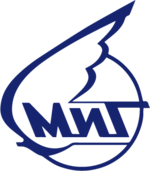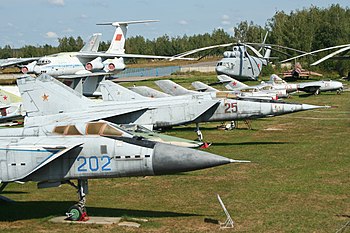Russian Aircraft Corporation "MiG" (Russian: Российская самолётостроительная корпорация „МиГ“, romanized: Rossiyskaya samolyotostroitel'naya korporatsiya "MiG"),[2] commonly known as Mikoyan and MiG, is a Russian aerospace and defence company headquartered in Begovoy District, Moscow.[3]
 | |
| Formerly |
|
|---|---|
| Company type | Division |
| Industry | Aerospace manufacturer and defense |
| Founded | 8 December 1939 |
| Founders | |
| Defunct | 2017; 8 Years Ago |
| Fate | merged into United Aircraft Corporation |
| Headquarters | Leningradsky Prospekt, Moscow , |
| Products | Military aircraft Civil airliners Unmanned aerial vehicles |
| Revenue | $1.37 billion[1] (2017) |
| $27 million[1] (2017) | |
| $8.59 million[1] (2017) | |
| Total assets | $3.58 billion[1] (2017) |
| Total equity | −$302 million[1] (2017) |
Number of employees | 10,090 (2013) |
| Parent | United Aircraft Corporation |
| Website | www |

Mikoyan was the successor to the Soviet Mikoyan and Gurevich Design Bureau (Микоя́н и Гуре́вич, МиГ; OKB-155 design office prefix MiG) founded in 1939 by aircraft designers Artem Mikoyan and Mikhail Gurevich. Mikoyan were notable for their fighter and interceptor aircraft which became a staple of the Soviet Air Force and Russian Air Forces, nations within the Soviet sphere of influence, and other nations such as India and many Arab states. Mikoyan aircraft were frequently used in aerial confrontations with American and allied forces during and since the Cold War, and have become commonly featured aircraft in popular culture. Mikoyan aircraft were the most produced jet fighter family.
In 2006, Mikoyan became a division of the United Aircraft Corporation in a merger with Ilyushin, Irkut, Sukhoi, Tupolev, and Yakovlev by decree of the Russian President Vladimir Putin.[4]
History
editMikoyan was established on 8 December 1939 as the Pilot Design Department of the Aviation Plant #1 and headed by Artem Mikoyan and Mikhail Gurevich. It was later renamed "Experimental Design Bureau named after A.I. Mikoyan" otherwise known as the Mikoyan Design Bureau or Mikoyan OKB.[5] In 1964 Gurevich retired, and Mikoyan died in 1970. He was succeeded by Rostislav A. Belyakov, and in 1978 the enterprise was named after Mikoyan.[6]
In 1995, Mikoyan OKB was merged with two production facilities to form the Moscow Aviation Production Association "MiG" (MAPO-MiG).[5] In the 1990s MiG began developing Mikoyan Project 1.44, a fifth-generation jet fighter, but the project was hampered by a lack of funding and was eventually canceled.[7]
In December 1999, Nikolai Nikitin was appointed the corporation's General Director and General Designer. Nikitin focused most of the company's resources on the development of the Tu-334 passenger aircraft at the expense of military programs.[5] This prompted the resignation in December 1999 of many of its leading military aircraft designers, including the chief designers and their deputies for the MiG-29 and MiG-31 programs.[5]
Nikitin was replaced by Valery Toryanin in November 2003, who was in turn replaced by Alexey Fedorov in September 2004.[8] In 2006, the Russian government merged 100% of Mikoyan shares with Ilyushin, Irkut, Sukhoi, Tupolev, and Yakovlev as a new company named United Aircraft Corporation.[4] Specifically, Mikoyan and Sukhoi were placed within the same operating unit.[9]
MiG failed to win any major aircraft tenders in the post-Soviet era, falling behind its Russian rival Sukhoi.[10] According to press reports, the company was shedding hundreds of employees in late 2017 due to a shortage of orders.
As of 2015 the company's business offering consists mostly of modernized MiG-29 aircraft.[10] MiG was developing a 4++ fighter, the MiG-35, with the first deliveries expected in late 2019. Mikoyan is set to fly the PAK DP aka MiG-41 their first stealth interceptor in 2025.[11][12]
Activity
editThe company specializes in the production of military aircraft. The Russian government has issued licenses to RSC MiG for the development, production and technical support of civil and military aviation equipment.
The total volume of production of MiG brand aircraft by domestic aircraft factories is about 47 thousand copies, and taking into account licensed production — about 62 thousand copies. The volume of production of cruise missiles developed at the Design Bureau and its branch at plant No. 256 (now JSC GosMKB Raduga named after A. Ya. Bereznyak) amounted to more than 12 thousand copies.
The company's revenue in 2009 amounted to 24.4 billion rubles. The company's order book reached $6.8 billion in April 2010.[13]
In 2014, JSC RSC MiG was named the winner of the third competition "Aircraft Manufacturer of the Year" in two nominations: "For the creation of a new scientific model of a physical phenomenon or technological process" and "For successes in the development of aviation equipment and components" (OKB of the year).[14]
Since June 1, 2022, it has been part of the association of PJSC UAC JSC RSK MiG, as well as JSC Sukhoi Company.[15]
See also
editReferences
edit- ^ a b c d e https://www.kartoteka.ru/card/99dd489e634ddb77bb9a8e341d679368/4b70a2dccb5183bafb39cada91d498f1/.
{{cite web}}: Missing or empty|title=(help) - ^ "Corporation today". Archived from the original on 1 August 2018. Retrieved 22 July 2018.
- ^ "Contacts Archived 2011-09-21 at the Wayback Machine." Mikoyan. Retrieved on 30 August 2011. "Russian Aircraft Corporation "MiG" 125284, Russian Federation, Moscow, 1-st Botkinsky drive, 7" – Address in Russian Archived 2011-08-28 at the Wayback Machine: "125284, Российская Федерация, Москва, 1-й Боткинский проезд, д.7"
- ^ a b Kramer, Andrew E. (22 February 2006). "Russian Aircraft Industry Seeks Revival Through Merger". The New York Times. Archived from the original on 9 June 2016. Retrieved 16 December 2017.
- ^ a b c d "Russian Fighter Aircraft Industrial Base: Parallels with the United States?" (PDF). Congressional Research Service. 8 November 2000. Archived from the original (PDF) on 29 August 2017. Retrieved 15 December 2017. This article incorporates text from this source, which is in the public domain.
- ^ "MiG - Russian design bureau". Encyclopedia Britannica. Archived from the original on 10 March 2018. Retrieved 16 December 2017.
- ^ Dowling, Stephen. "Rostislav Belyakov: The man behind the MiGs". BBC Future. Archived from the original on 20 December 2017. Retrieved 16 December 2017.
- ^ "The State of the Russian Aviation Industry and Export Opportunities" (PDF). Conflict Studies Research Centre. Archived (PDF) from the original on 16 December 2017. Retrieved 16 December 2017.
- ^ "Ares". www.aviationweek.com. Archived from the original on 21 March 2010.
- ^ a b "Russia's Once-Mighty Fighter Jet Firm MiG Struggling as Rivals Make Gains". The Moscow Times. 2 July 2015. Archived from the original on 24 March 2017. Retrieved 16 December 2017.
- ^ "Everything We Know About Russia's Futuristic MiG-41 Fighter Jet". 18 April 2023.
- ^ "The High-Speed Russian Fighter Jet That May Jump the SR-71 Blackbird as Fastest Plane". 10 March 2023.
- ^ "РСК "МиГ" возобновит крупносерийное производство истребителей "МиГ-29"". Ведомости (in Russian). 14 April 2010. Retrieved 7 June 2024.
- ^ "Нашлемная система ОКБ Микояна для летчиков победила в конкурсе "Авиастроитель года" - ТАСС". TACC (in Russian). Retrieved 7 June 2024.
- ^ Новости, Р. И. А. (1 June 2022). "ОАК, "Сухой" и "МиГ" объединили в одну компанию". РИА Новости (in Russian). Retrieved 7 June 2024.
External links
edit- Migavia.ru – official site of MiG "OKB" successor enterprise
- Russian Aviation Museum, MiG Pages Archived 30 May 2017 at the Wayback Machine